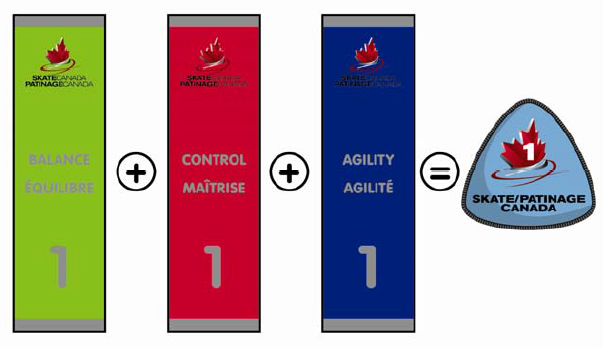
The skater must be at least three years old by October 1 and willing to go on the ice without their parent.
Parents cannot accompany skater on-ice unless they are registered as a Parent PA.
Ratio on this session is 10:1.
There are three main stations on the ice during each CanSkate session:
Balance
Control
Agility

Each week, one of the zones is designated as the Fun Zone, which will have some extra fun added to the circuit. A Fast Track encircles the perimeter of the ice rink, outside of the group stations.
Each session consists of a warm-up, three small group lessons (10 minutes each at one of three stations with a different coach at each station), a group activity and a cool-down with a focus on continuous movement. Skaters use the Fast Track to move from station to station.
The sessions incorporate upbeat music, teaching aids and a wide variety of activities to add fun and variety. Ratio on this session is 10:1.
Required Equipment
Having the right equipment will ensure that a skater's experience on the ice is fun, successful and safe. Skates should be comfortable, fit well and provide firm ankle support.
All CanSkate participants (up to & including Stage 5) must wear a CSA-approved hockey helmet while on the ice.
Most department stores (e.g. Walmart, Canadian Tire), sports stores (e.g. SportChek, Play It Again Sports) and figure skating stores sell skating equipment in a variety of price and quality ranges. The choice is yours. If you have any questions or concerns regarding equipment for your skater, please speak to the CanSkate Coordinator, a coach or a Board member.
How to check fit of skates
- Partially lace boots through instep.
- Slide foot forward so toes can touch the front but are not cramped.
- Stand with weight equally distributed over both feet and bend knees.
- The space at the back of the heel should be no more than a pencil width.
- Tie laces loosely over the toe and front of the boot and snugly over the ankle and instep.
- Skates should fit snugly around the ankle and heel.
- Skate should fit the width of the foot – they should be snug but comfortable and allow toes to wiggle.
- There should be no looseness or creases in the boot. The tongue should be well padded and wide enough to cover the front of the ankle and stay in place.
- Walk around in the skates. Skates should feel comfortable. Ankles should not wobble.
Tips for purchasing skates
- Wear only one pair of tight fitting socks or tights (the same pair that will be worn when skating).
- Avoid buying a larger size for skater to "grow into". If they are too loose, skates will not be supportive.
- A leather boot is preferable to vinyl. Laces and hooks are preferable to buckles. Moulded plastic skates are not recommended.
How to tie skates
- Be sure the tongue is centered and pulled all the way up.
- Start at the toe of the skate and tighten laces comfortably over the toe and front of the boot.
- Before tightening the hooks, wiggle your toes to make sure the skates feel comfortable.
- Tie laces snugly around the ankle and tie a tight bow or double knot.
- Make sure extra lace is tucked away. Do not wrap laces around the ankle.
Care of skates
- Always wear protective guards when walking off-ice to protect sharpened blade. NEVER walk on concrete surfaces without skate guards.
- Dry the blades and sole plate completely with a cloth after skating to prevent rust.
- Protect blades with soft guards while in skating bag.
- Remove skates from bag and guards from blades after each use. Allow boots and blades to air dry completely.
- NEVER store skates with hard guards on.
- Unlace skates sufficiently before removing them so that the back of the boot will not break down or rip.
Sharpening your skates
- Sharpen skates as soon as they are purchased.
- Use a good skate-sharpening company.
- Re-sharpen skates after approximately 30 hours of skating (depending on usage and care).
- More frequent sharpening may be required if the skater walks on concrete, rubber or carpeted surfaces without guards, if the blades are not wiped dry, or if there are severe nicks and rough surfaces on the edges of the blade.
- If your child wears figure skates, the bottom pick should not be removed - the pick is part of the design of figure skates and is essential to proper balance.
Clothing
- Clothing should provide warmth, allow for movement and provide some protection from falls.
- Avoid clothing that is too bulky or restrictive.
- Snow suits are not recommended
- Turtlenecks and a sweater or jacket on top should be sufficient.
- Windbreaker pants or track pants over long comfortable pants are recommended to keep your skater warm and dry.
- Warm mittens or gloves are a must. Have a backup pair in case they get wet.
- Long scarves are not to be worn.
- Coaches use permanent markers or bingo dabbers to draw circuits on the ice. This can stain clothes and should be taken into consideration when choosing what to wear.
Helmets
- Hockey helmets with CSA approval are necessary for skaters of any age up to and including CanSkate Stage 5.
- Fit should be snug. Both the strap and the helmet should be adjustable.
- Face masks or cages are recommended for additional protection.
Safety pointers for skaters
- Get up quickly after falling down.
- Look in the direction of travel when skating backwards.
- No pushing, playing tag or bumping into others or the boards.
- No food, gum or candy on the ice.
- Coaches, club directors and/or CanSkate co-ordinator should be advised of any skaters with special medical conditions.
